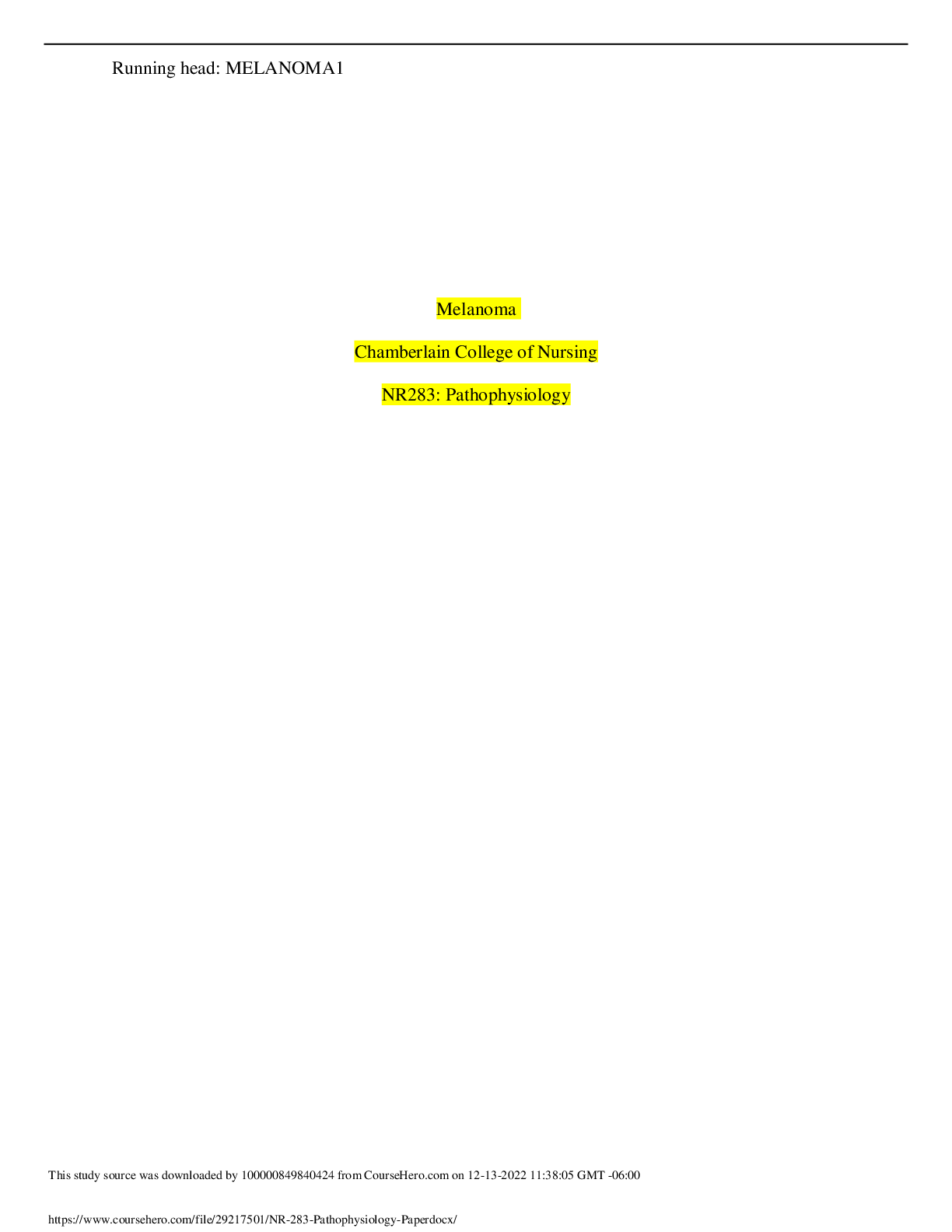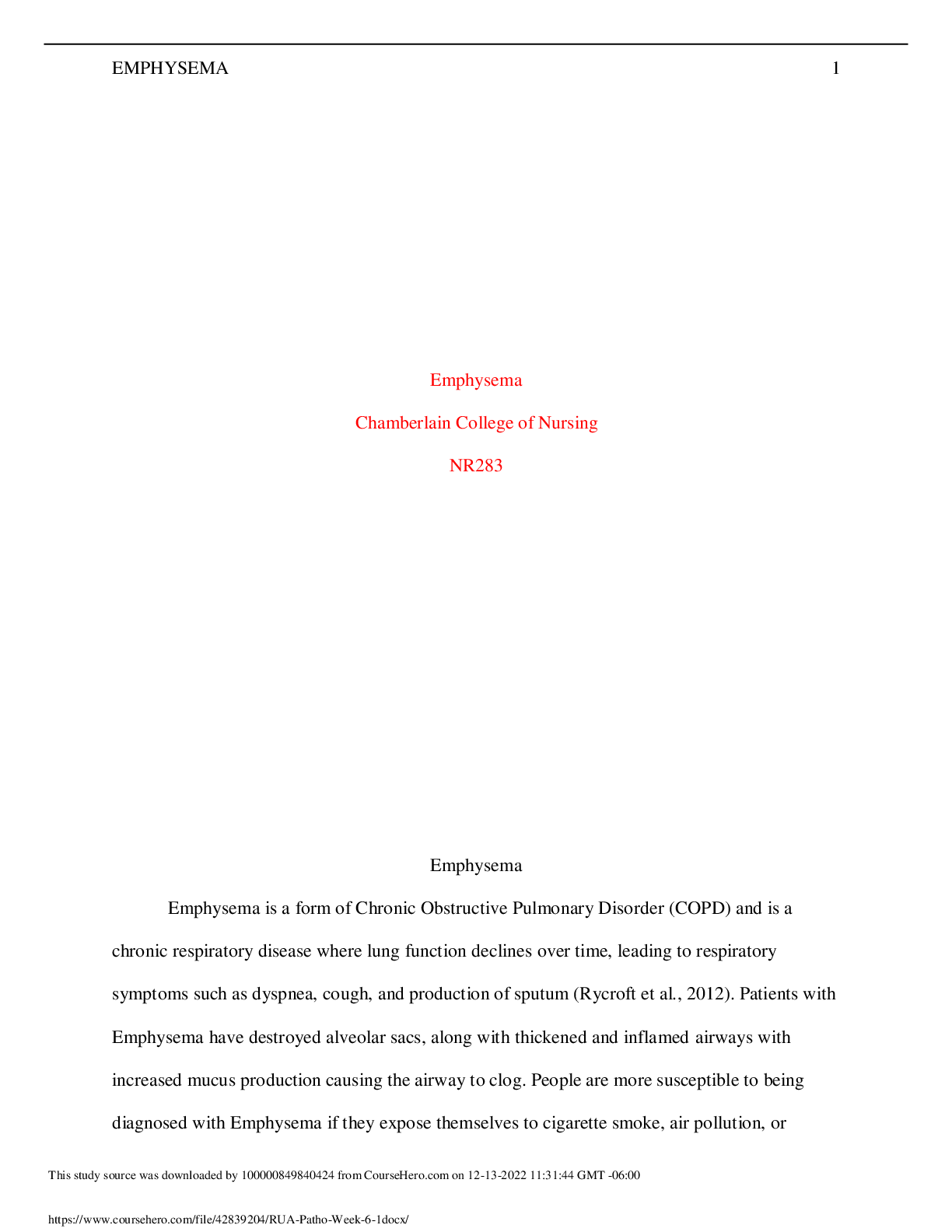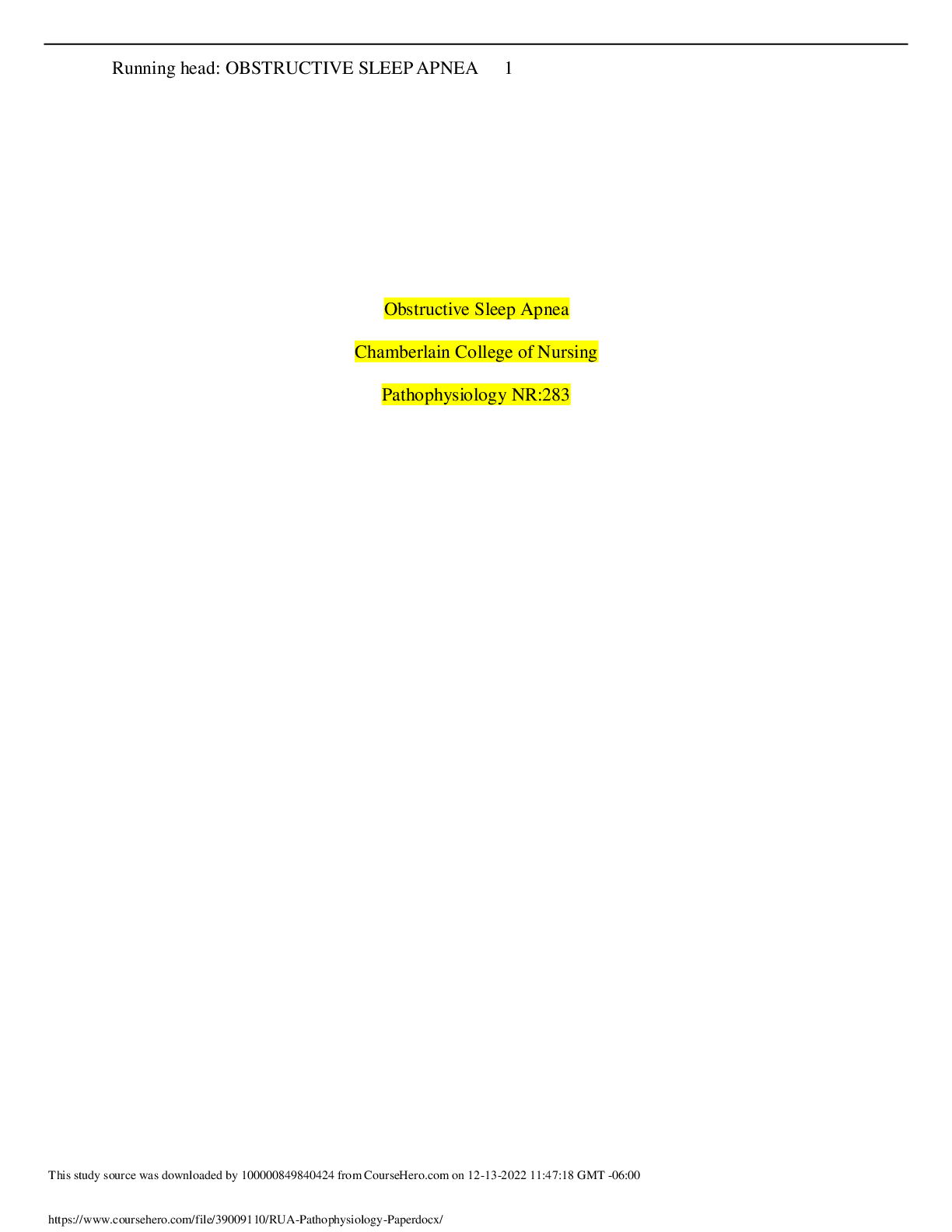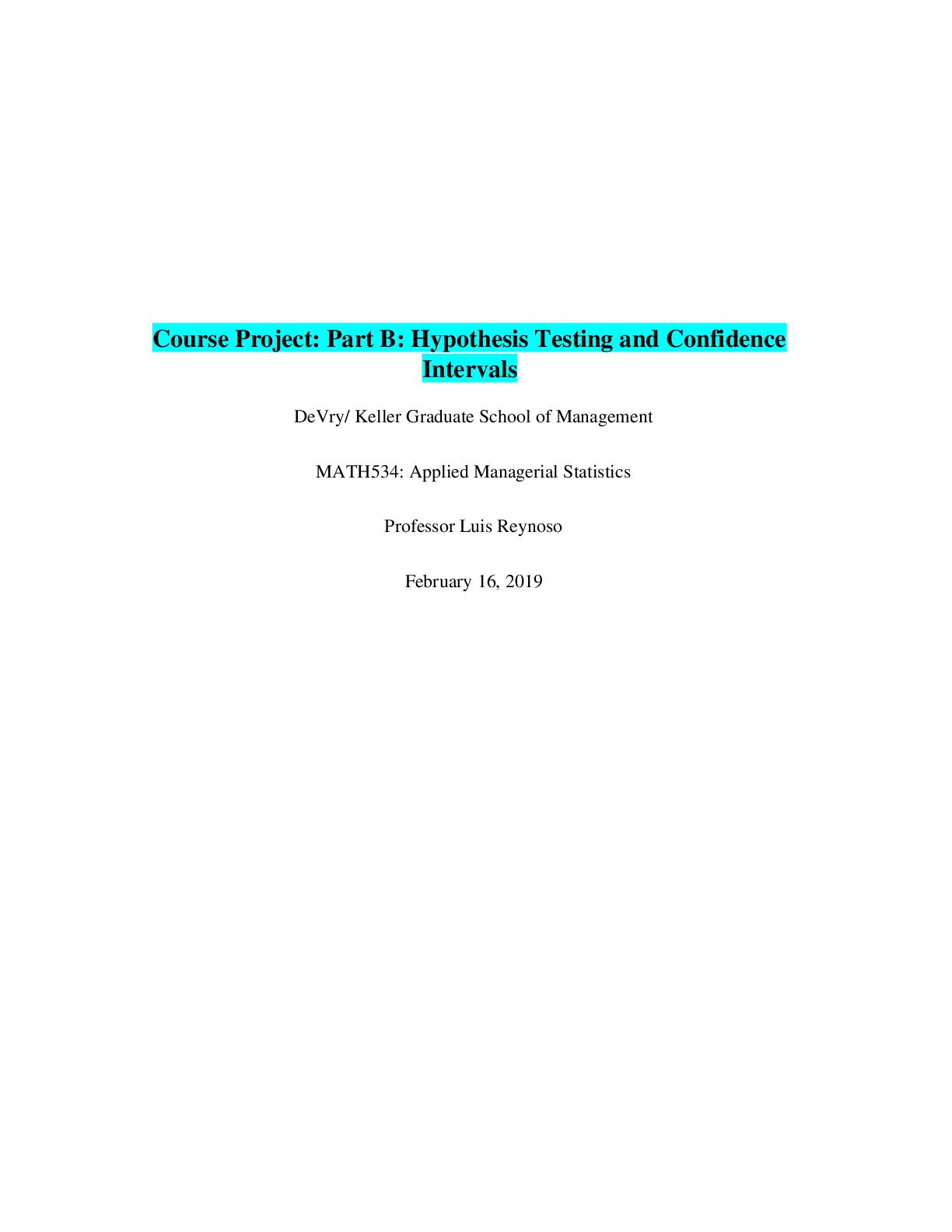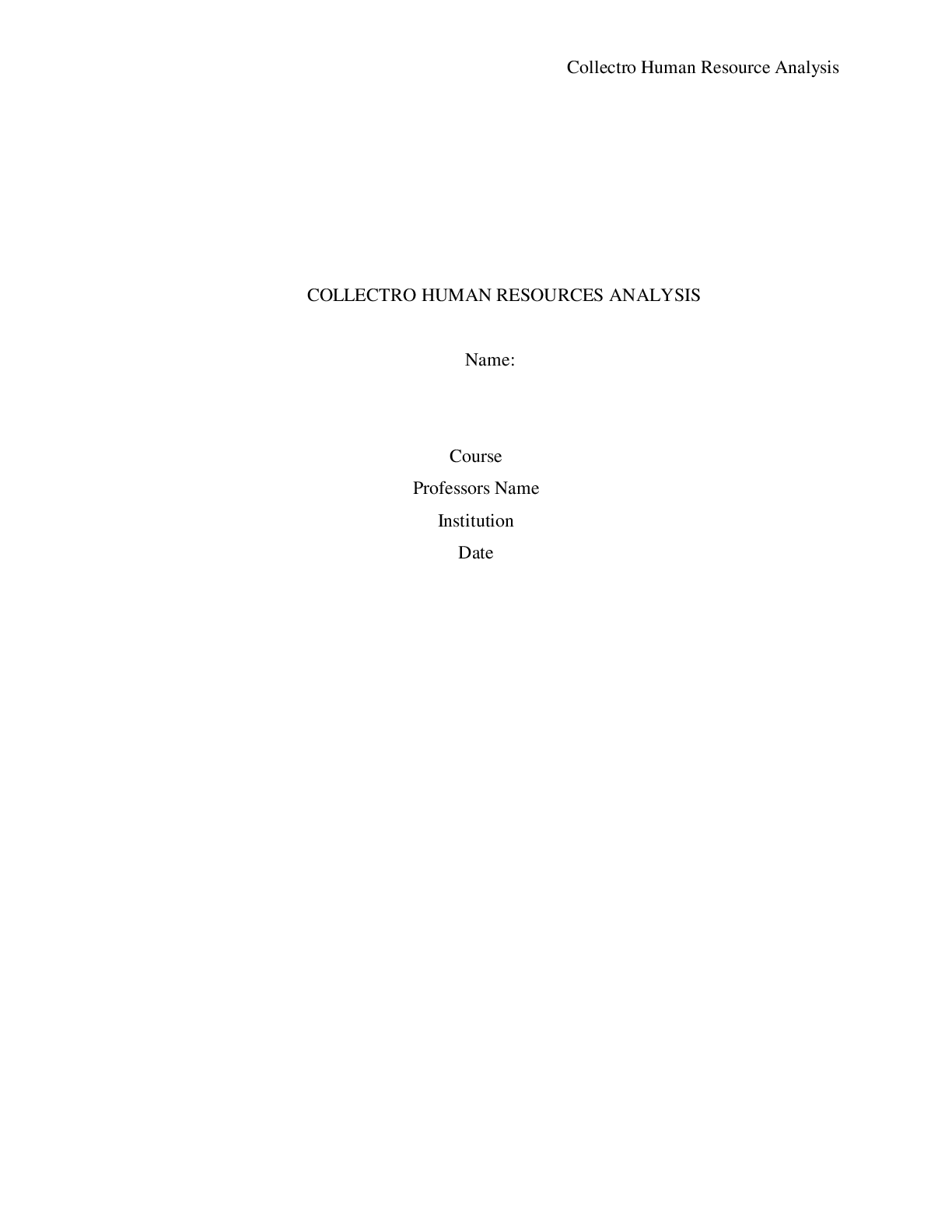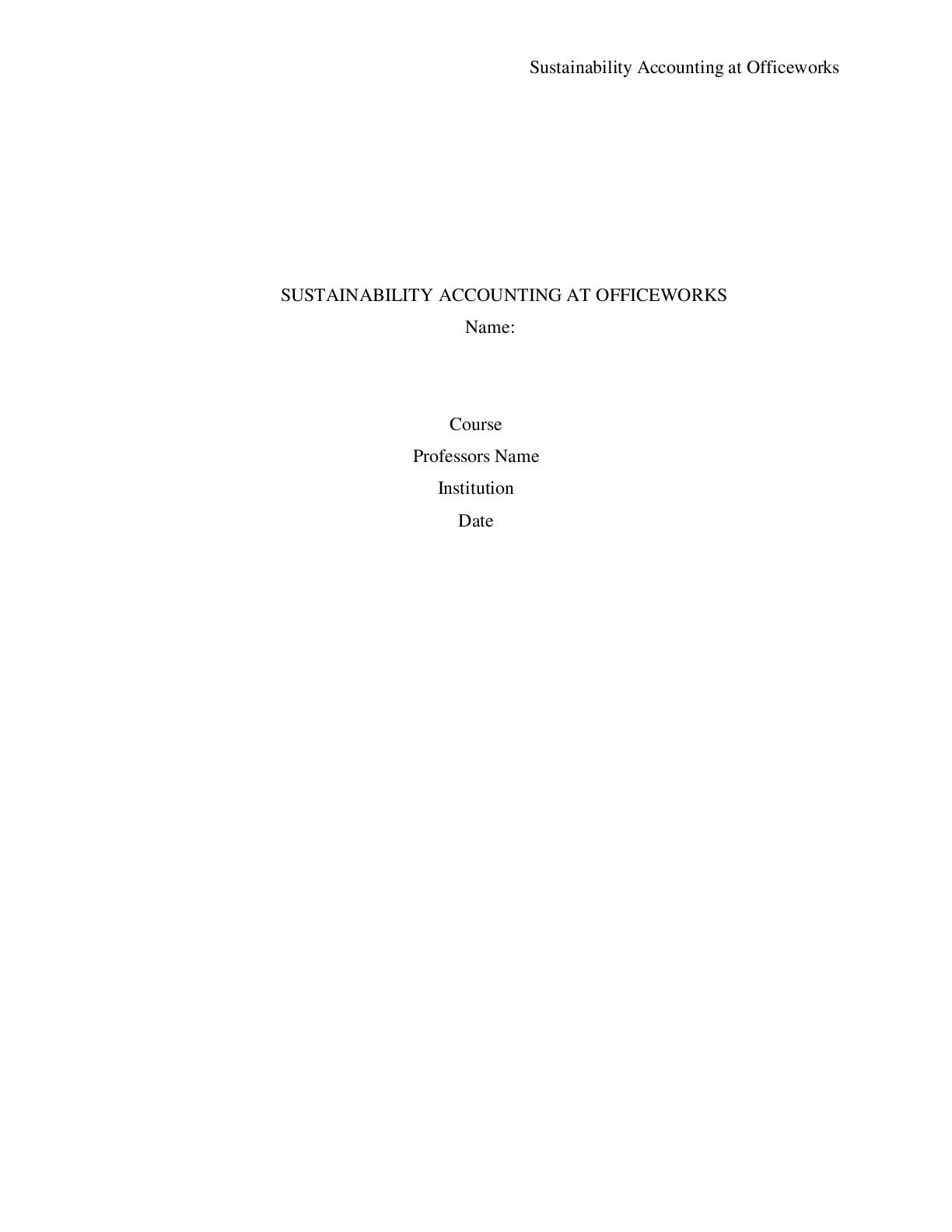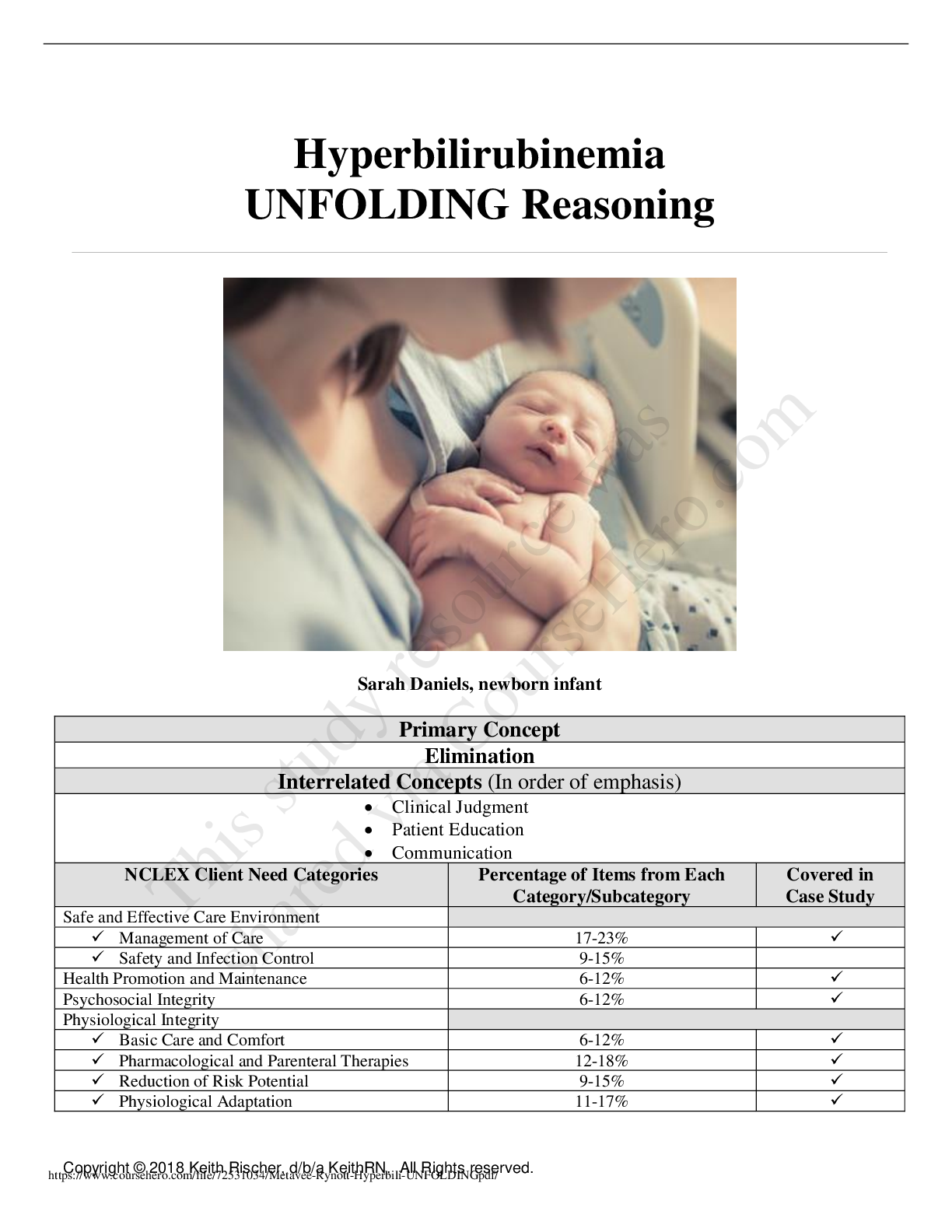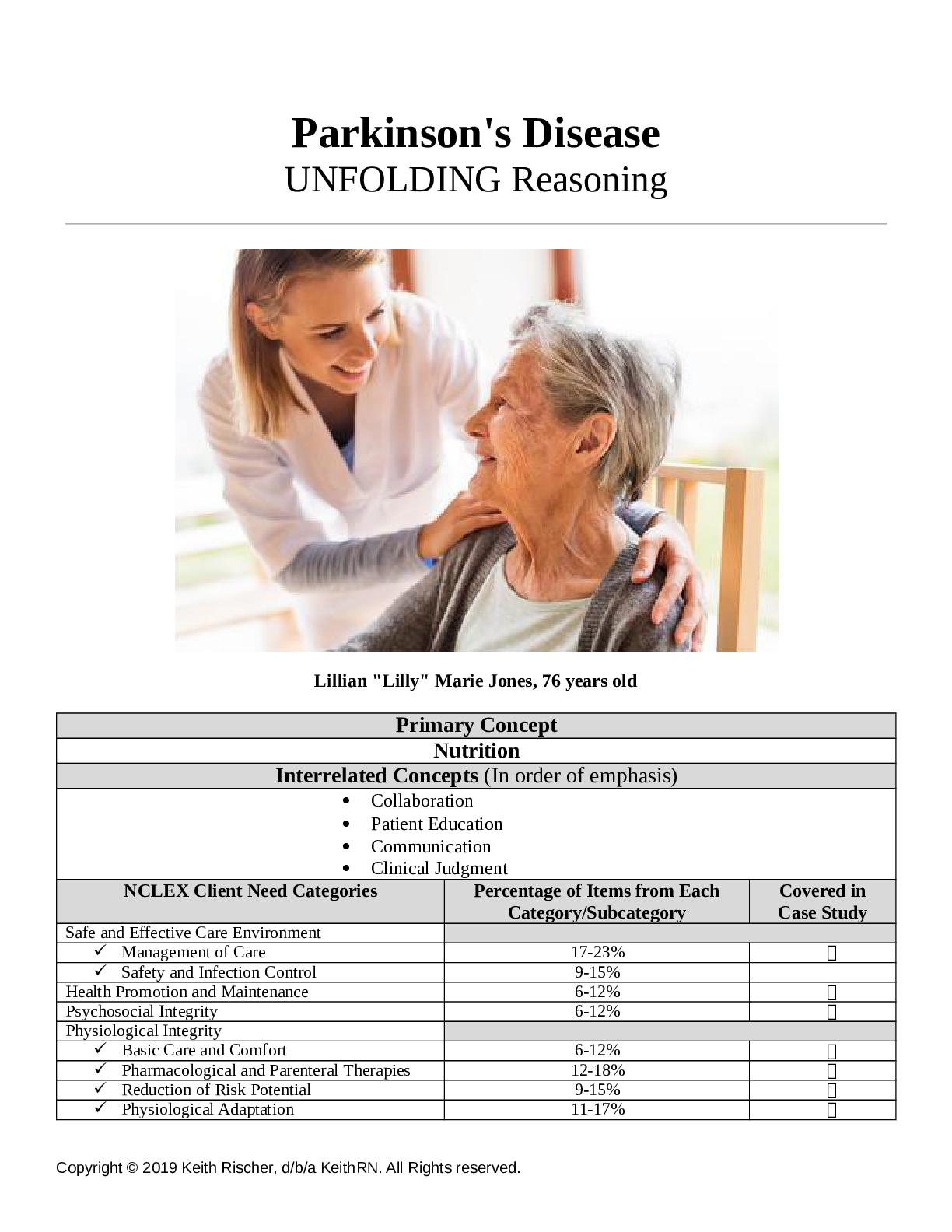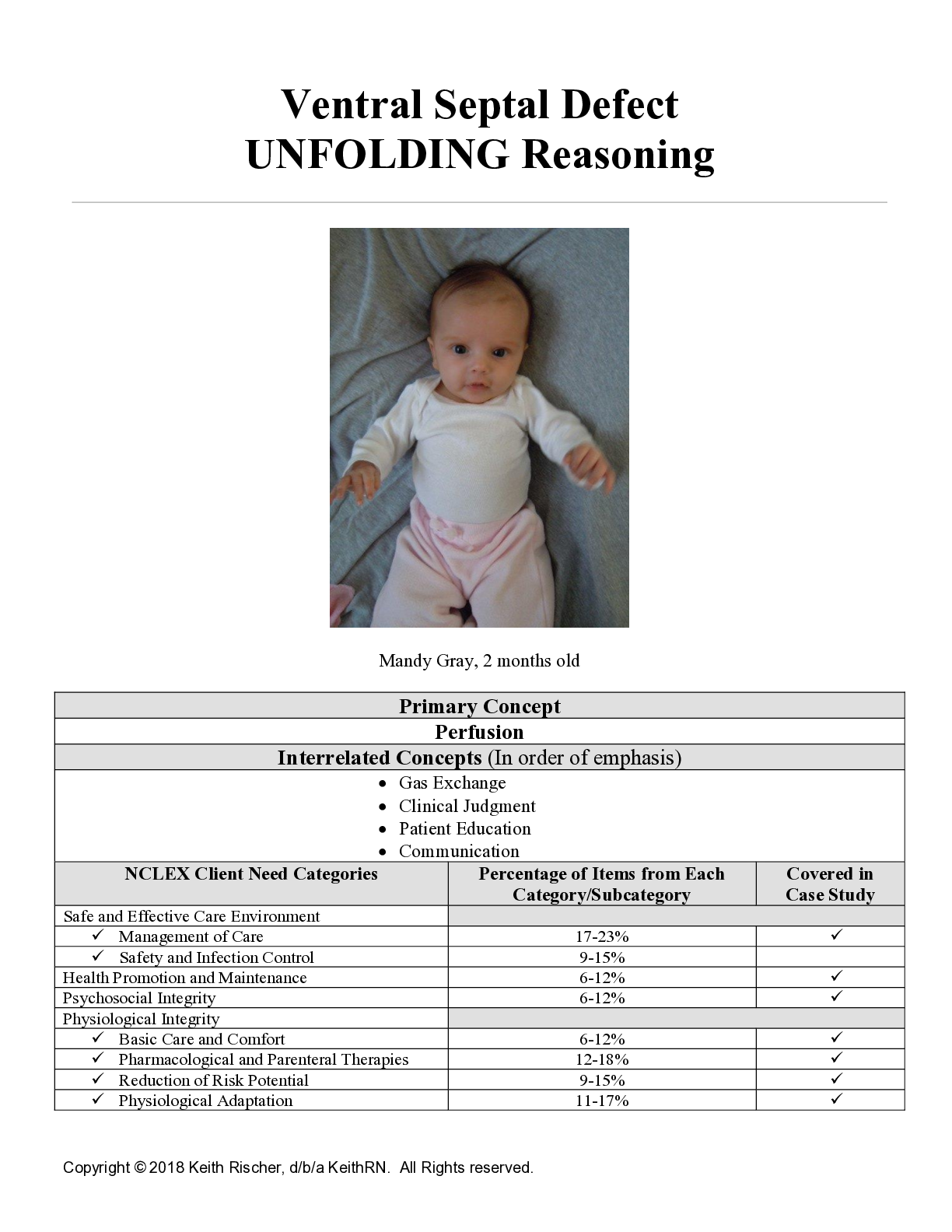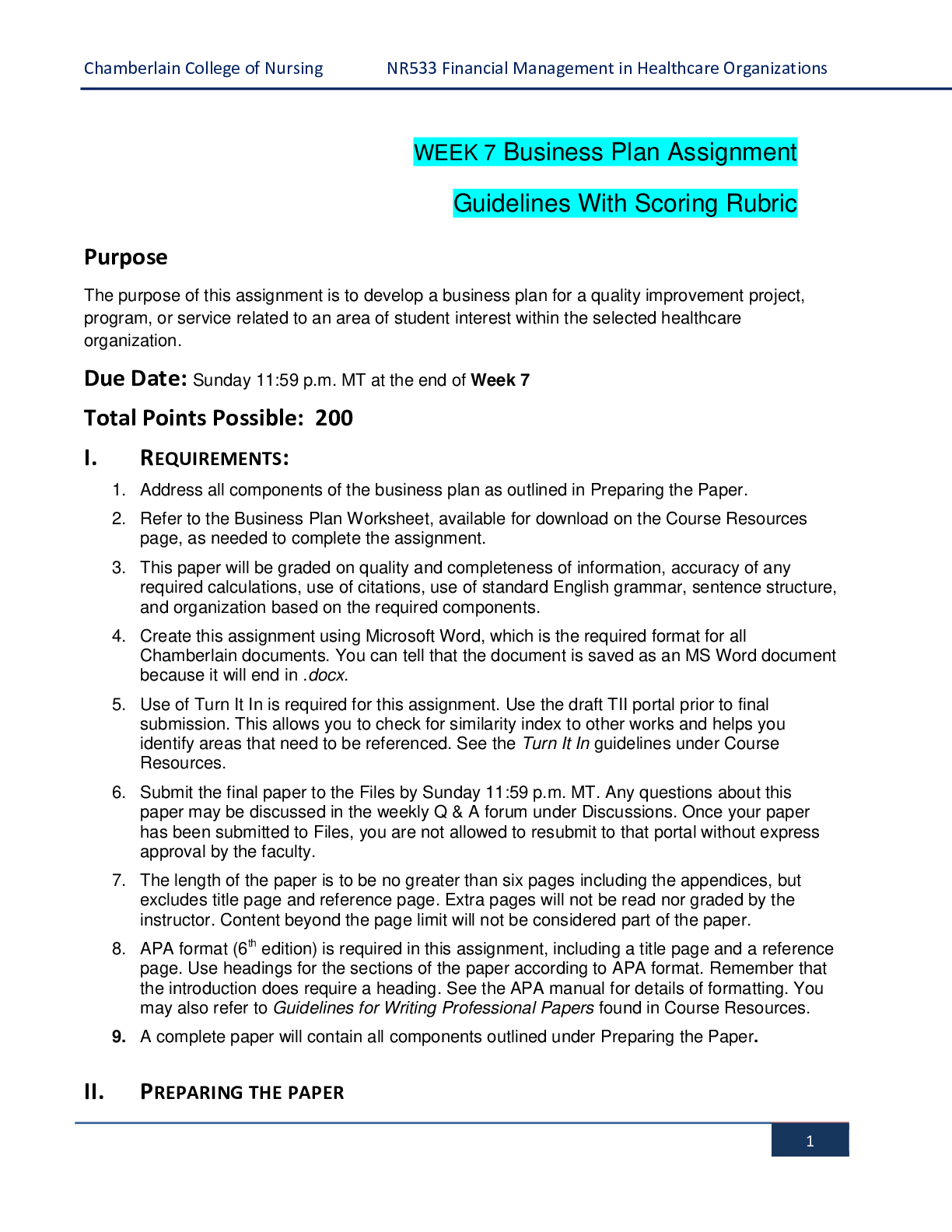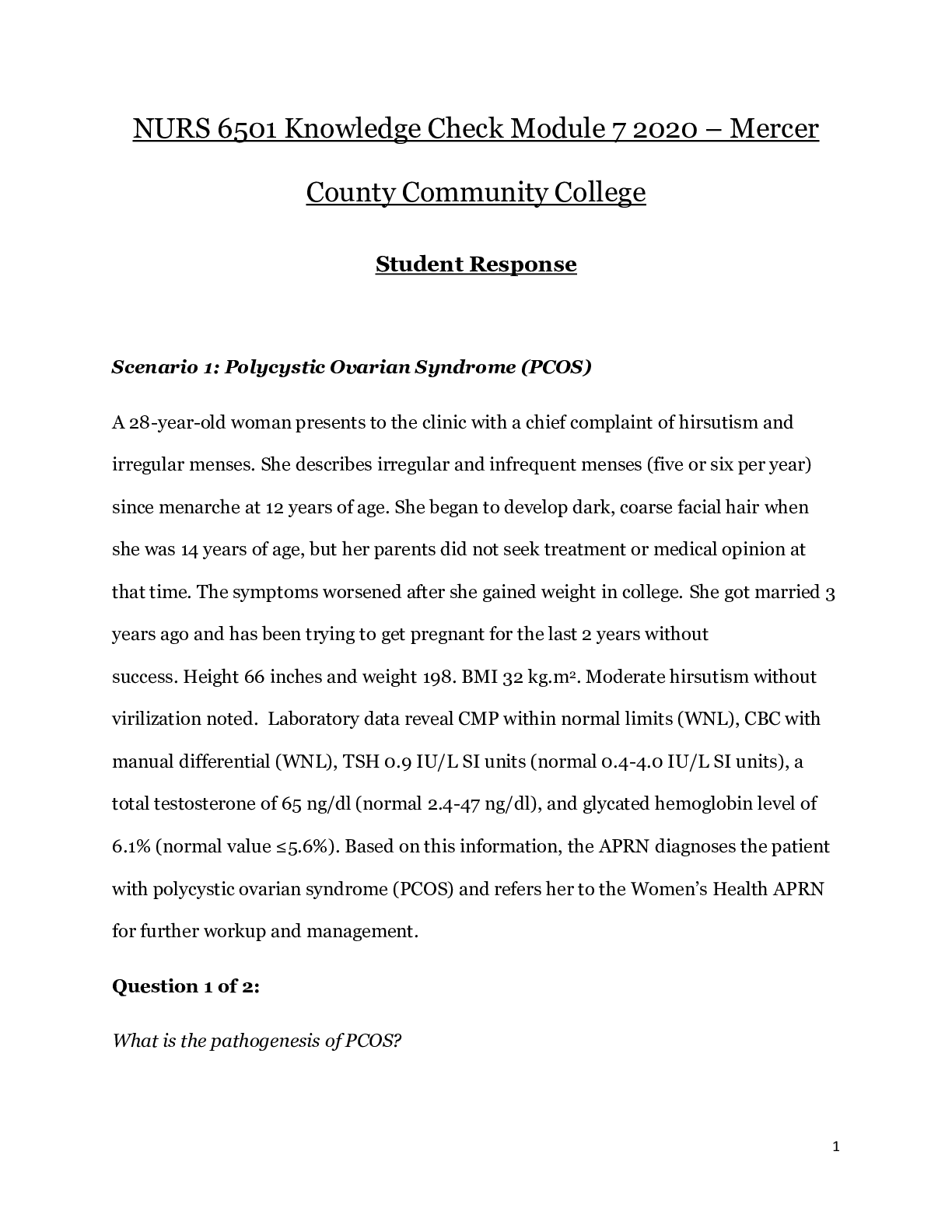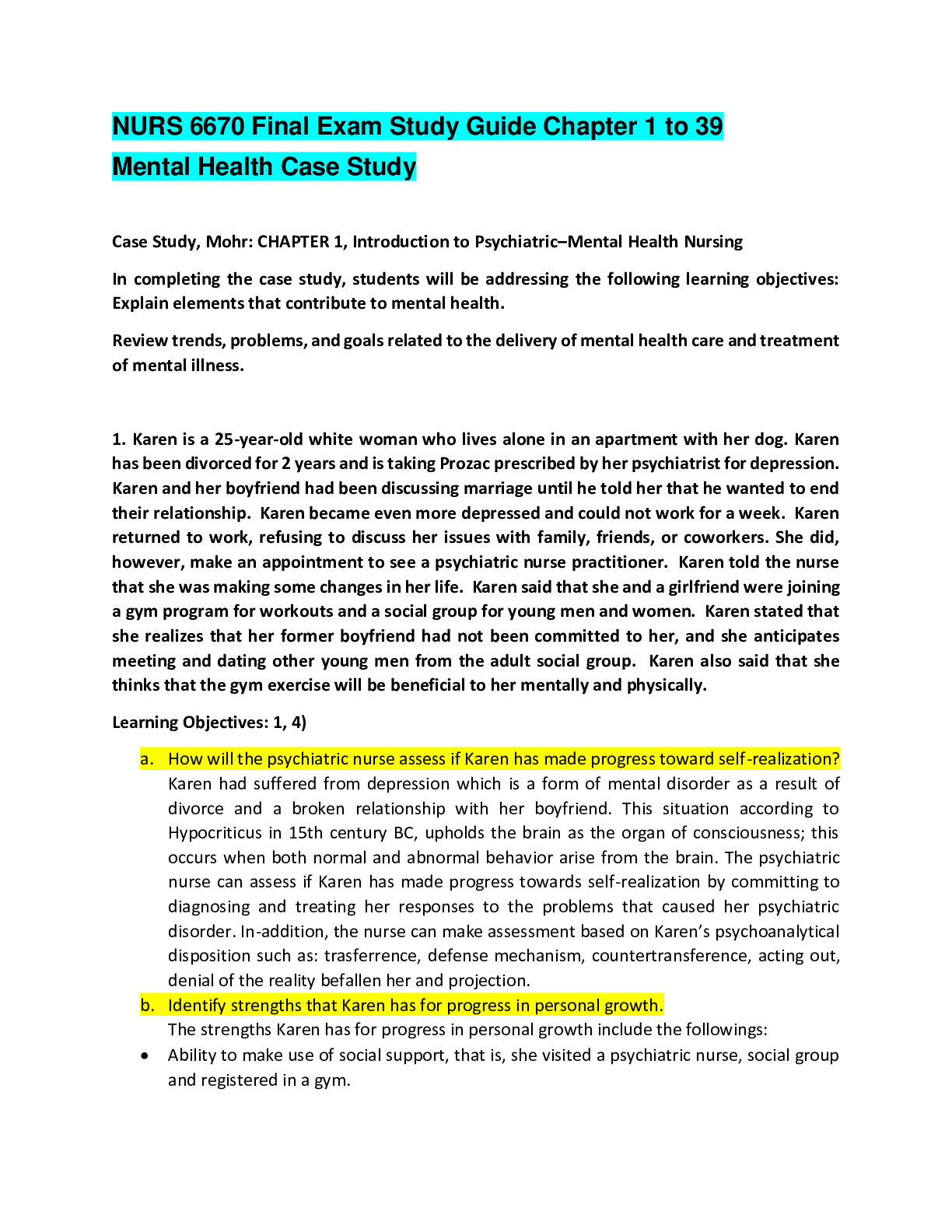Pathophysiology > CASE STUDY > (GRADED A) NR-283 Week 6 RUA: Pathophysiological Processes Guidelines: The Epidemiology of Acute Myo (All)
(GRADED A) NR-283 Week 6 RUA: Pathophysiological Processes Guidelines: The Epidemiology of Acute Myocardial Infarction
Document Content and Description Below
The Epidemiology of Acute Myocardial Infarction XXXX Chamberlain University College of Nursing NR283-11040: Pathophysiology The E... pidemiology of Acute Myocardial Infarction According to Mechanic and Grossman (2020), there are over three million people in the world each year that are dying from a very serious disease of Acute Myocardial Infarction (Acute MI) also commonly known as a Heart Attack, in which more than over one million of that number of deaths are in the United States. An Acute Myocardial Infarction is a blockage or clot that is preventing blood to flow to the heart which will cause tissue damage to the coronary arteries. Your coronary arteries are vessels that circulate oxygenated blood to your heart and by having blocked arteries could lead to multiple heart attacks and or even death. There are many risks factors that lead to an Acute MI, like stress, overweight/obesity, high blood pressure, family history of heart attacks, and or tobacco use (there are many more risk factors, these are just the more common causes). Most Acute MI’s are developed in elder aged individuals and most deaths are commonly seen in women than in men, but the signs in both genders vary in symptoms. In men, you will see that they feel the pain more in their chest (tightness) and in women, it is more common that they develop nausea along with the sensation of heartburn or indigestion. Depending on the severity and how quick the response is to someone who is experiencing Acute Myocardial Infarction could possibly save one’s life. Etiology and Risk Factors of Acute MI When it comes to the conditions of what causes an Acute Myocardial Infarction there are many risk factors, the most common one’s are individuals that have high blood pressure, high levels of stress, family history of heart attacks, overweight/obese, and or consistent amounts of tobacco use. A lot of the risk factors have common contributions like atherosclerosis. For example, high blood pressure, family history of heart attacks, and or obesity all consist of having high cholesterol, which is build-ups of fatty deposits that can cause blockages in the arteries [CITATION Hea20 \l 1033 ]. Fatty deposits are plaques that can rupture in a coronary artery that will block the blood from getting to the heart, and because of that is why Acute MI is more critical and or more developed in elder aged individuals. Because the older you get the denser the muscle of your heart works and adding tension like stress and tobacco use puts more strain on your heart. Acute MI is more commonly seen in elder aged individuals because the older you get the less physical you are and with less mobility. The many years of living with stressors and the many risks of developed disease due to age can also contribute to Myocardial Infarction. Although men are the most at risk of developing a heart attack woman have the most deaths of an Acute MI. According to Harvard Health Publishing (2016), the death rate of heart attacks in women are higher than in men because they tend to live longer lifespans. Unsure, but it is to be believed that the number of risks in women heart attacks is often after they have gone through menopause, I speculate that the chemical imbalance of estrogen affects the blood vessels and causes a rise in blood pressure. Although there are many symptoms of Acute MI, there may be different signs seen in women when having a heart attack than in men. Men tend to have tightness in their chests, sweating, and pressure, whereas women may feel nausea along with dizziness, and or indigestion. Because these symptoms seem similar to other minor diseases women tend to not seek medical attention during the first signs. Pathophysiological Process & Complications Due to not seeking medical attention when first signs of symptoms can lead to ischemia and hypoxia which causes myocardial tissue damage that once damaged it may be irreversible. This process then leads to clots or blockage also known as coronary thrombosis. Without enough oxygenated blood flow to the heart the tissue dies, the dead tissue is then surrounded by a cascade because it can either restore the tissue or it can make the tissue irreversible, which then can cause arrhythmias. Apoptosis and necrosis affect the ventricular systolic and diastolic functions of the cardiomyocytes. Over time the damaged myocardium develops a scar to begin the healing process [ CITATION Fra15 \l 1033 ]. Although there is a healing process, this process is usually more successful in either a young adult aged individual or in an older aged individual who has had its first experience of Acute Myocardial Infarction. Too many incidences of heart attacks tend to not heal well and or may end in death. When knowing if you or an individual is experiencing an Acute Myocardial Infarction it is important to know the signs of having a heart attack. There are two experiences of signs and they are either typical or atypical and it is important to know which is which. The typical signs are signs that are more usually seen for a particular disease and atypical are signs that are not usually seen for a disease or that may be associated with other diseases. Women are seen to have more of atypical signs when men experience more typical signs, both of which are needed immediate attention once noticed and or experienced. According to Harvard Health Publishing (2016), the most common are typical signs and symptoms of a heart attack are sweating, pain in the chest (tightness) that leads to the neck, jaw, and or left arm, and the nonclassic or atypical signs and symptoms are shortness of breath, nausea, back pain, a sensation of indigestion, or unexplained fatigue. When people experience the tightness/chest pain it is due to angina which is a lack of blood flow to the heart, which is caused by thick plaque buildup in the inner walls of the arteries. The restriction of the blood to the heart causes complications that if the blood vessels separate the aorta could rupture. Pericarditis is another cause of tightness in the chest, inflammation of the pericardium that develops gives sharp pain when you breathe in (Mayo Clinic, 2017). If symptoms are left untreated it could damage the heart muscles or even death to an individual. Diagnosis of Acute Myocardial Infarction If an individual has experienced a heart attack with typical or atypical symptoms the medical staff would run tests to be sure that their diagnosis is correct. The type of tests that would be done is the patient’s subjective data, a twelve-point lead ECG, and some blood tests. When a patient is tested, the first testing that is done is questions of what has occurred to determine if the patient may be having an Acute MI and then an electrocardiogram is performed on the patient. This is to determine the type of heart attack the patient is experiencing and wherein the heart is being affected. Then blood test is drawn, like Cardiac Troponin I or Troponin T (biochemical markers), these tests will tell you the size and around the time the heart attack started[ CITATION Cle19 \l 1033 ]. Conclusion In conclusion, the number one leading cause of death in the world is heart disease, one, in particular, Acute Myocardial Infarction also known as a “heart attack” is one of the most common ones that are being diagnosed amongst the elder aged individuals. As you age it is more important to take care of your health, eat right, get daily physical exercise, as well as get annual check-ups. Heart attacks are also known as “silent killers” because of the nonclassic signs that someone could be experiencing and not notice until it is too late. It is also important to know the signs and symptoms because if you are having a heart attack or someone that you know that is having one you would know to react quickly and by doing so will save that individual’s life. References Cleveland Clinic. (2019). Heart Attack (Myocardial Infarction) Diagnosis and Tests. Retrieved from my.clevelandclinic.org: https://my.clevelandclinic.org/health/diseases/16818-heart- attack-myocardial-infarction/diagnosis-and-tests Frangogiannis, N. G. (2015). Pathophysiology of Myocardial Infarction. National Library of Medicine, 5(4):1841-75. doi:doi: 10.1002/cphy.c150006 Mayo Clinic. (2017). Chest Pain-Symptom & Causes. Retrieved from mayoclinic.org: https://www.mayoclinic.org/diseases-conditions/chest-pain/symptoms-causes/syc- 20370838#:~:text=A%20heart%20attack%20results%20from,carry%20blood%20to %20your%20heart. Mayo Clinic. (2020). Heart Attack-Symptoms & Causes. Retrieved from mayoclinic.org: https://www.mayoclinic.org/diseases-conditions/heart-attack/symptoms-causes/syc- 20373106 Mechanic, O. J., & Grossman, S. A. (2020). Acute Myocardial Infarction. StatPearls. Retrieved from https://www.ncbi.nlm.nih.gov/books/NBK459269/ [Show More]
Last updated: 1 year ago
Preview 1 out of 6 pages
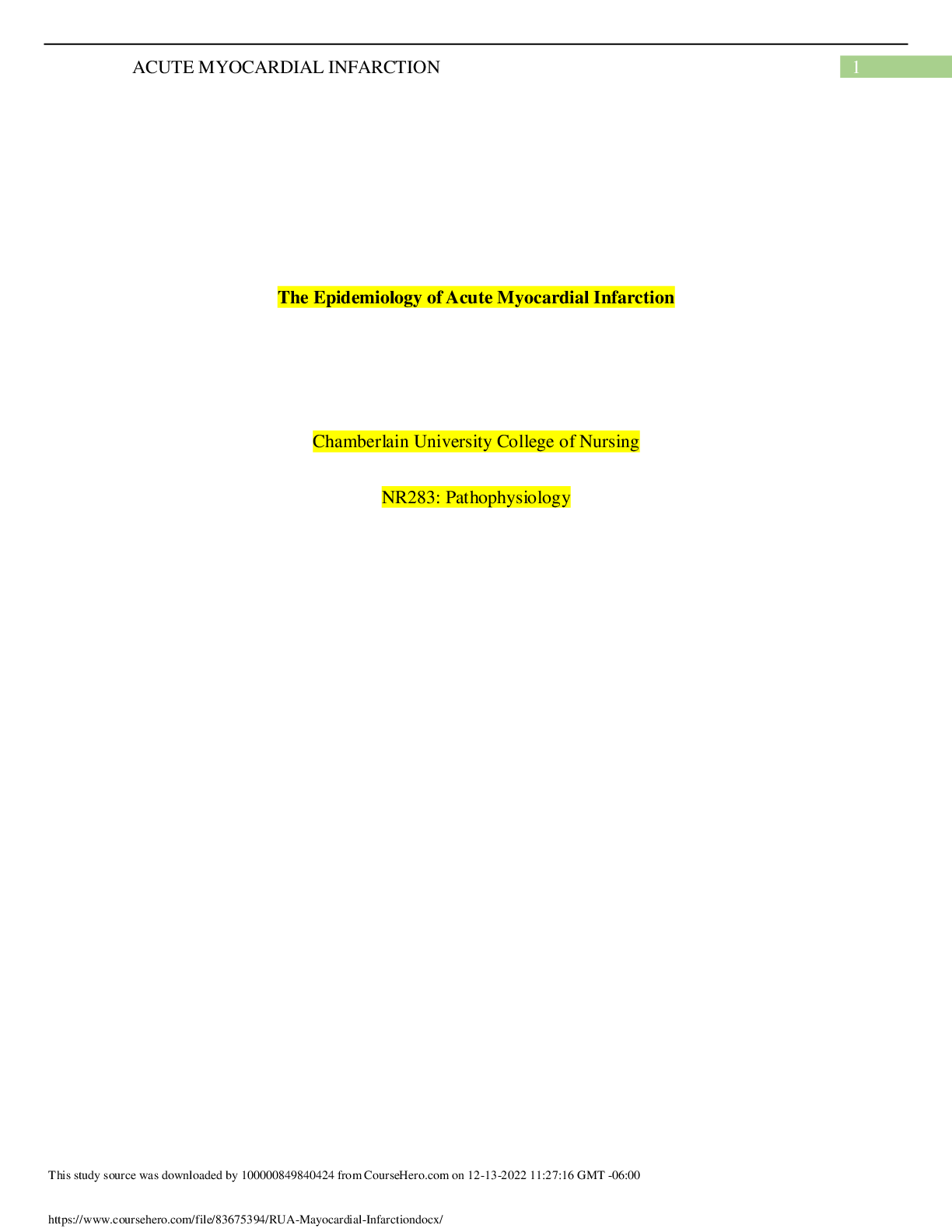
Reviews( 0 )
Document information
Connected school, study & course
About the document
Uploaded On
Jun 21, 2022
Number of pages
6
Written in
Additional information
This document has been written for:
Uploaded
Jun 21, 2022
Downloads
0
Views
109



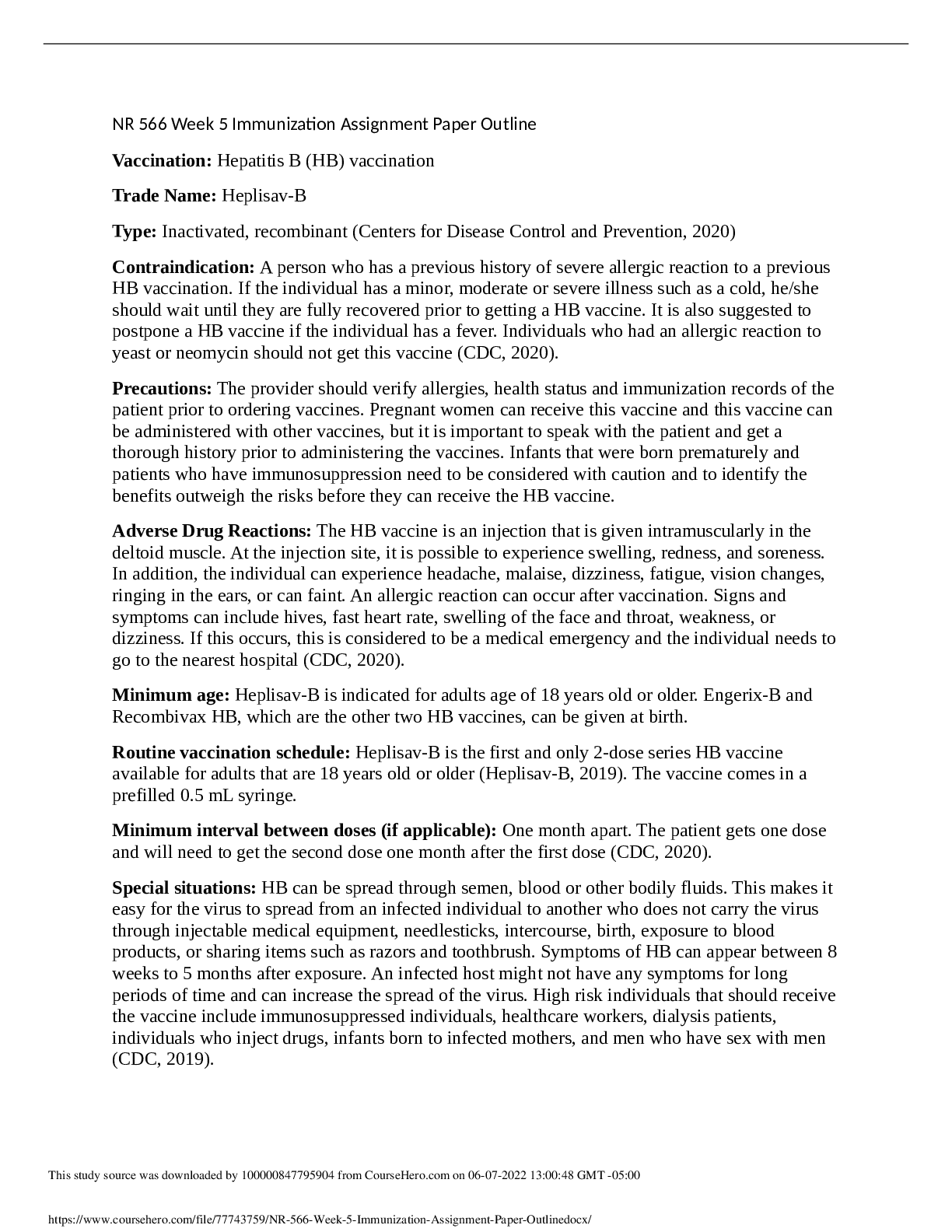

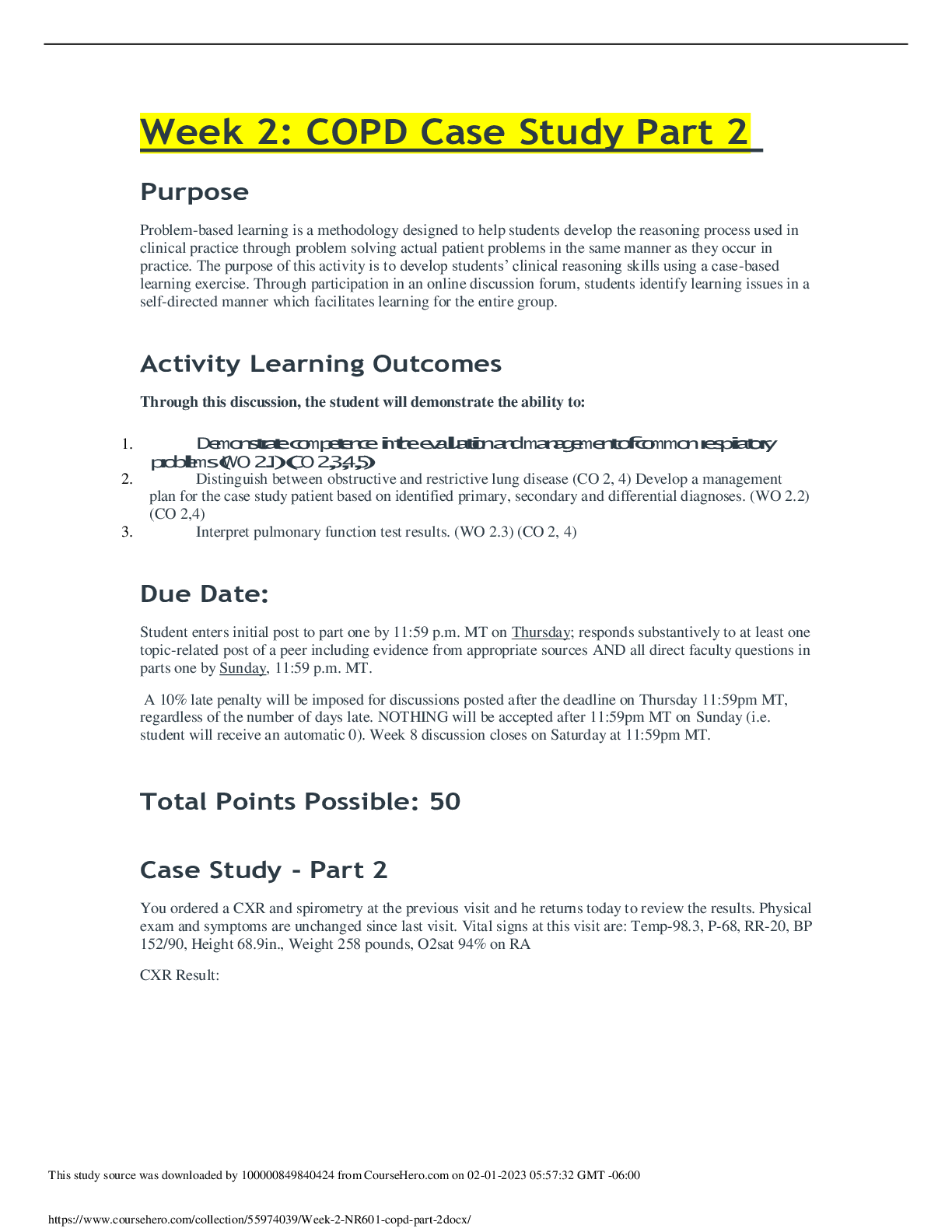
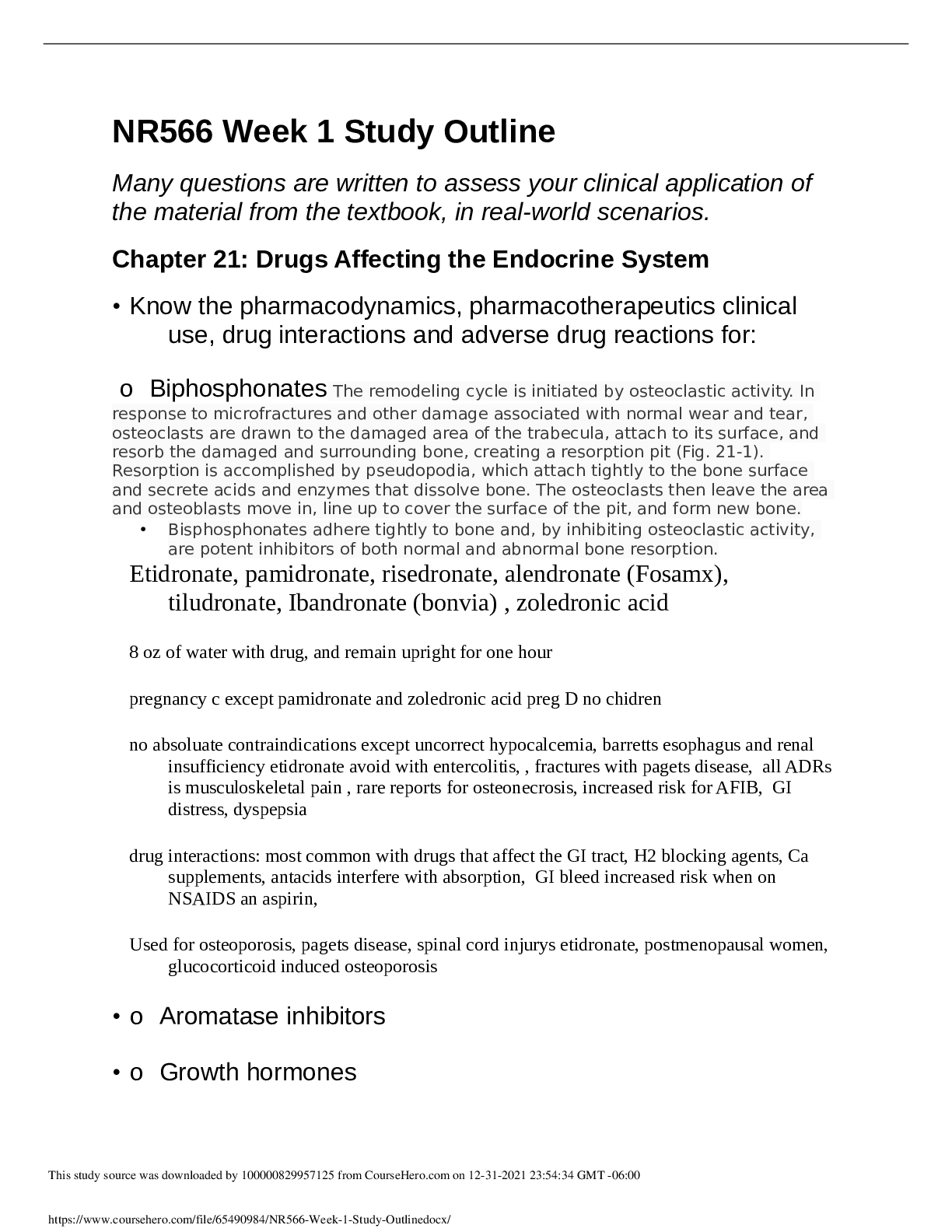

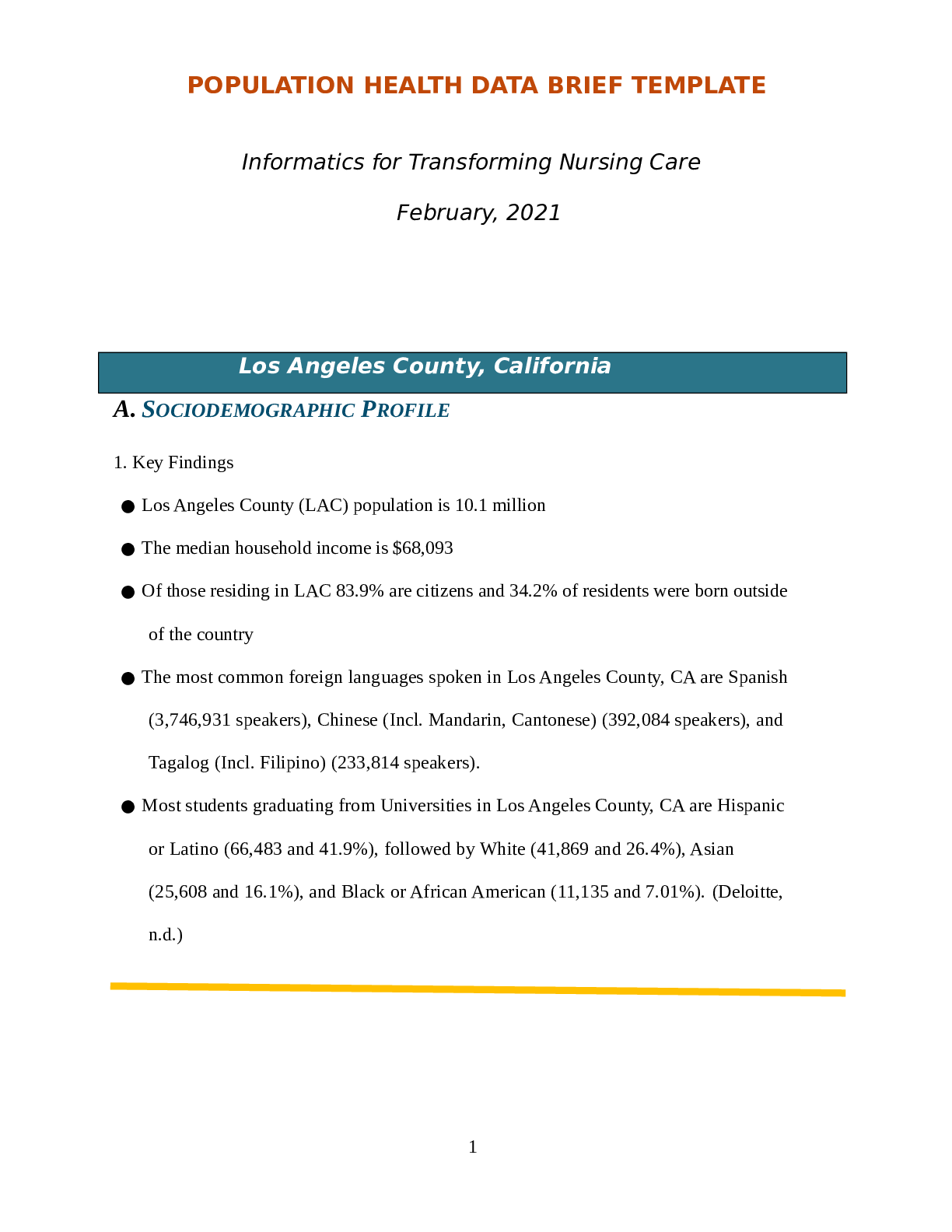

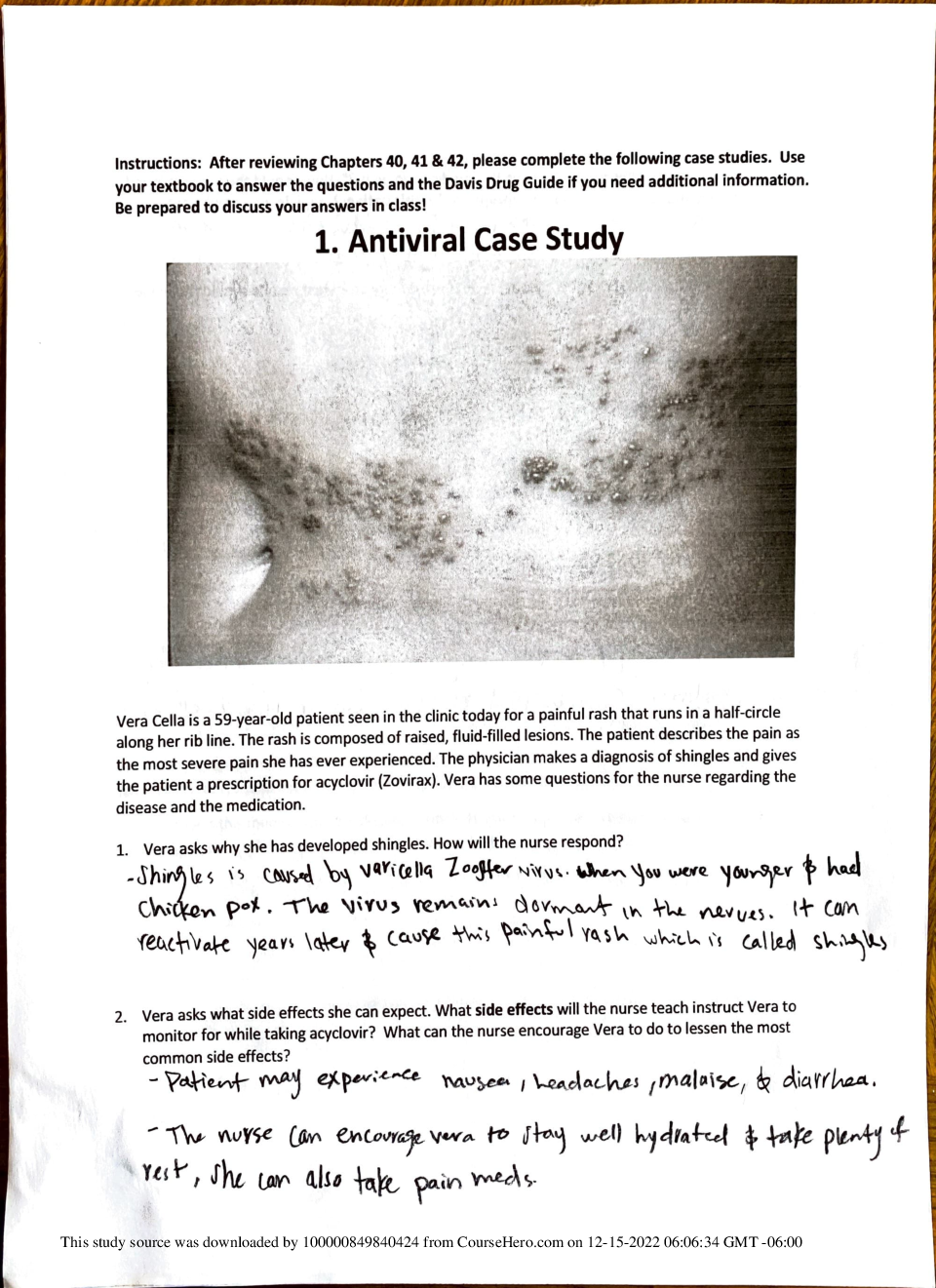


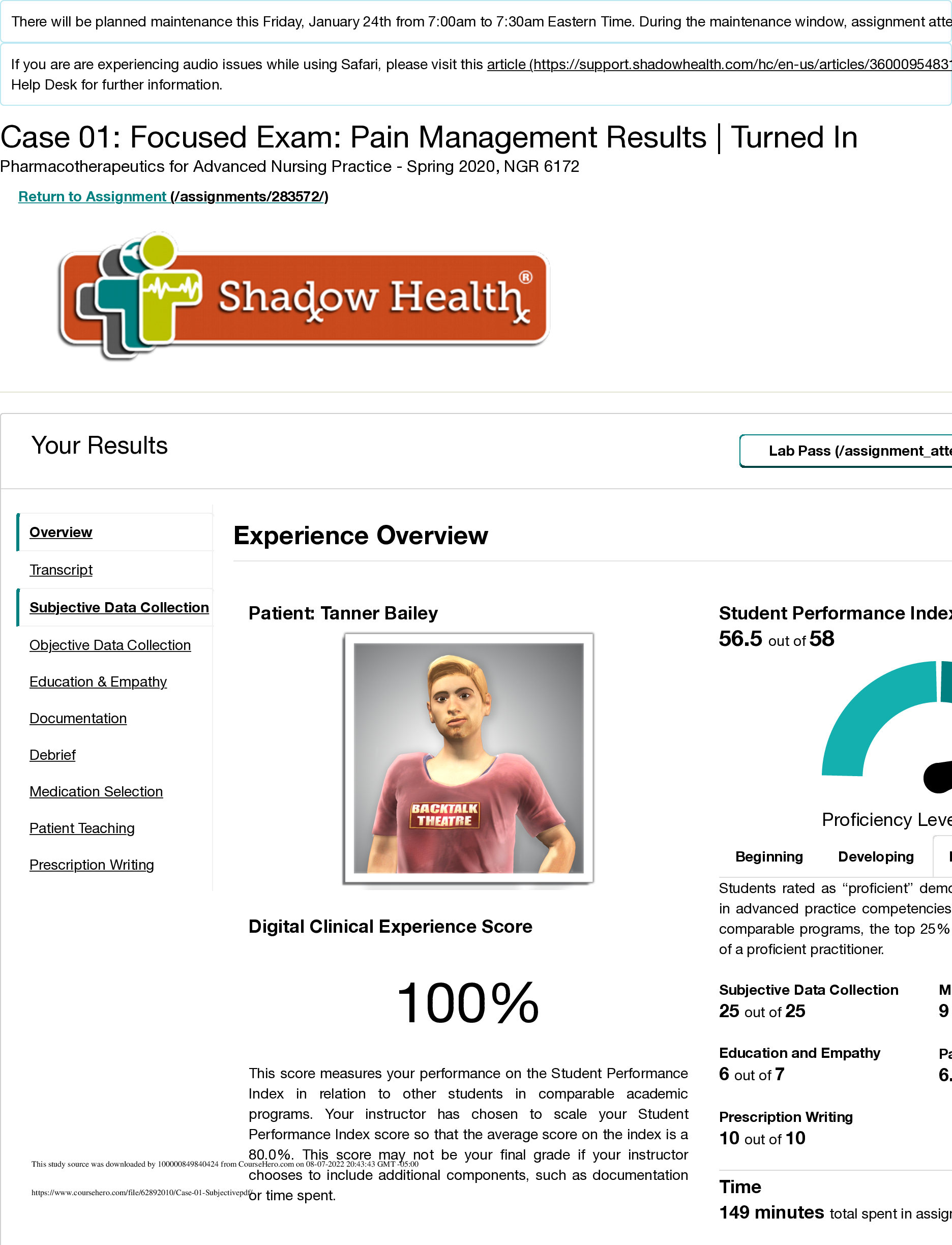
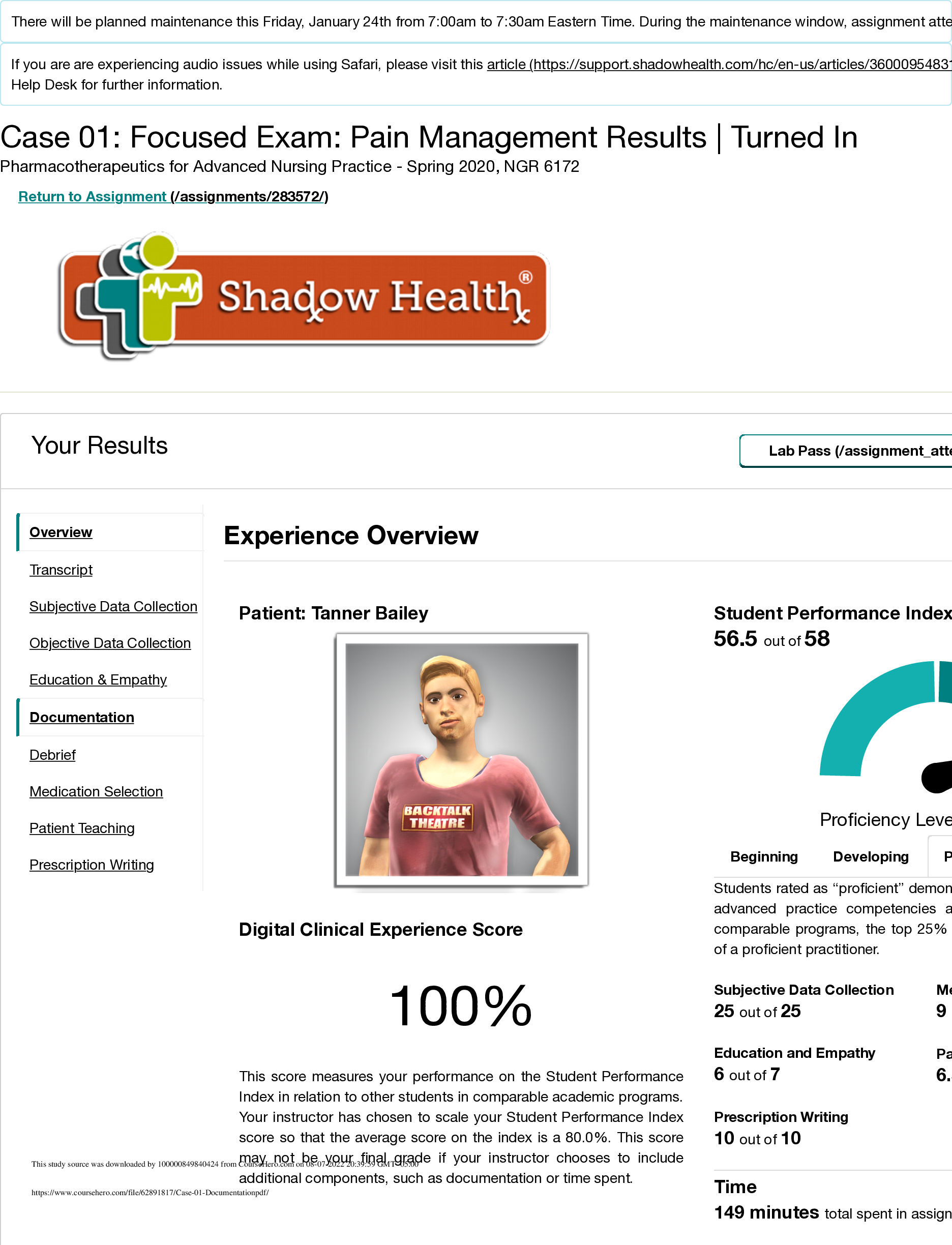

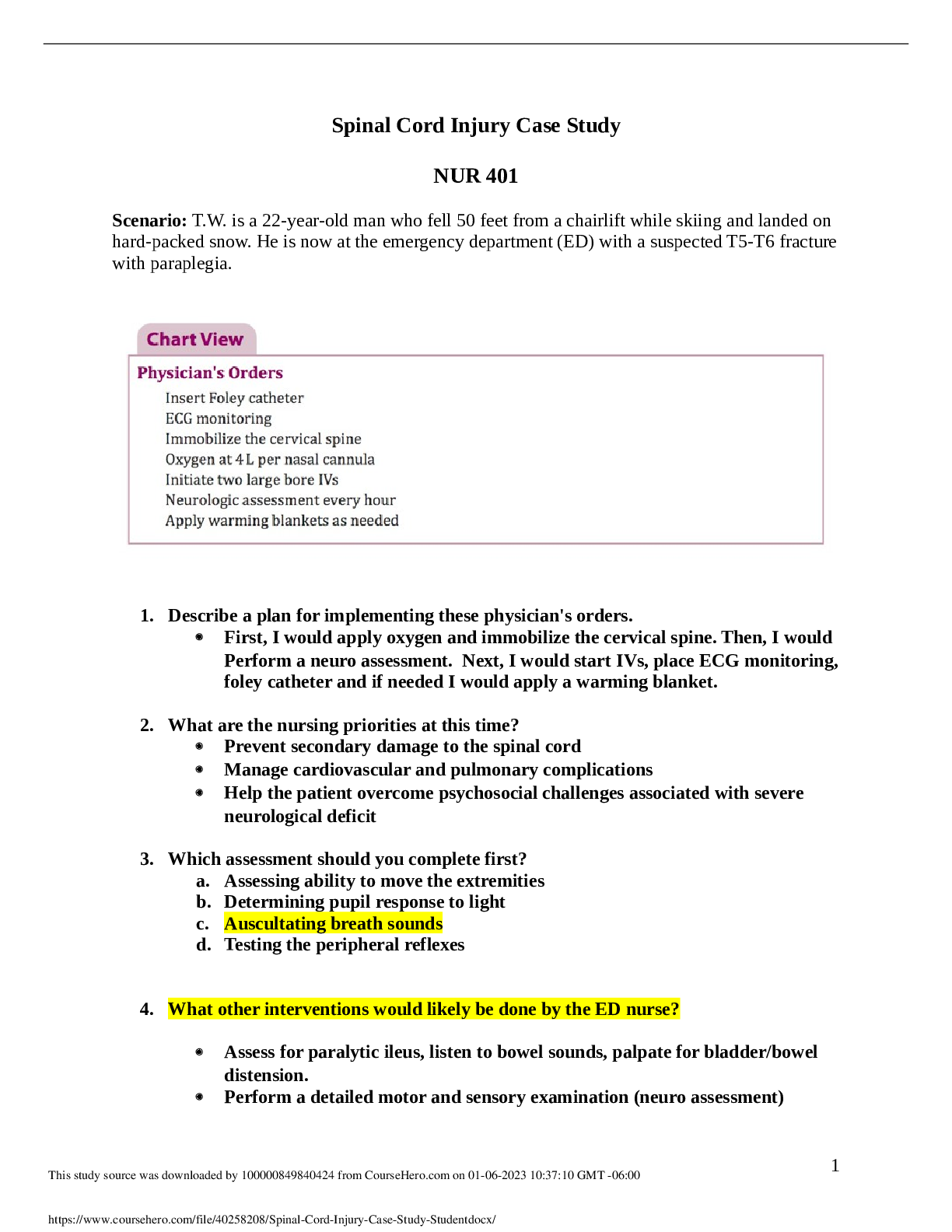
 (1).png)
